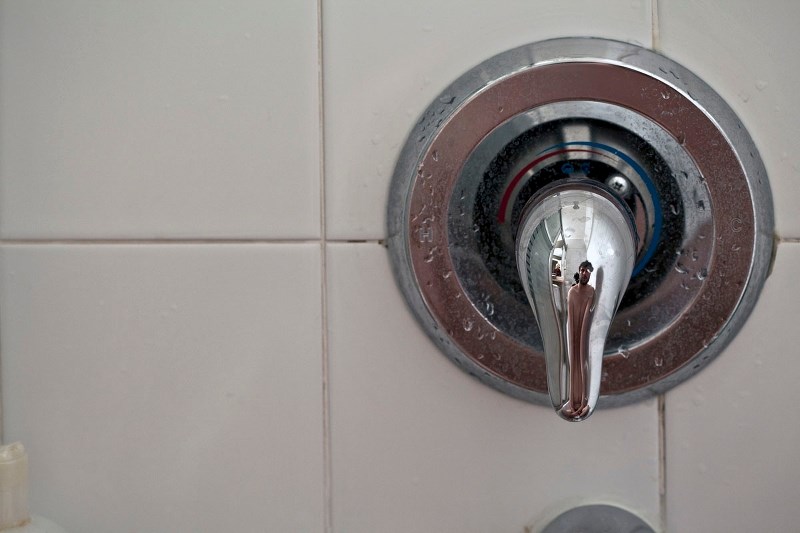Leave it to Brad Necyk to take a selfie with me at the Art Gallery of Alberta, right after the opening of Future Station, the 2015 Alberta Biennial of Contemporary Art. A major exhibit such as this deserves to be captured in the appropriate way, after all. St. Albert’s pre-eminent intermedia artist has spent years in self-examination and self-awareness so what’s one more photo with his cellphone, right?
It doesn’t dawn on me until later, at Enterprise Square (where the second part of the exhibit – and Necyk’s own work – is on display) that the full importance of that selfie hits me. Necyk’s work consists of three sizable photographs in which he has taken his own picture as reflected in a variety of the chrome surfaces of the fixtures of his bathroom, doing what one usually does in the bathroom, although you don’t see much.
Necyk’s own contributions to the show are not unfamiliar approaches in fine art. Everybody knows that artists are often their own models, right?
“There’s art historical genealogy to artist self-portraits,” he professes. “I wanted to continue on down that line. There used to be these great Flemish paintings where the artist would put himself in this little tiny reflection in a knob or something. They would find these ways to be present in their paintings.”
Some famous examples include Lucian Freud’s play with double mirrors in Reflection with Two Children and M.C. Escher’s Hand with Reflecting Sphere. Except of course, those artists weren’t nude. These images of Necyk’s personal moments aren’t done for shock value. Artists have always explored the body and the washroom is a natural fit since it offers so many opportunities for self-care and self-observation.
“It was about a body. I was my own subject. Even though it was a psychological state, there are biological mechanisms that are underpinning it. This is a very biological space. It’s an intimate space and for me, it’s authentic to do such a thing.”
Indeed, it would be strange otherwise.
The ‘selfie as self-portrait’ was only part of the inspiration, Necyk continued. He openly talks about his diagnosis of bipolar disorder, an issue he previously explored “the institution of psychiatry,” even photographing shelves of various medicines, for exhibitions within the last two years.
It seems like a large part of these works was borne out of his own self-examination of both his physical person and his psyche.
“For me, they were from a period of mental illness. I would spend a lot of time in the washroom. I’d spend so much time looking at this faucet, and I’d see this morphed version of myself, this warped image. I thought, ‘this is fantastic!’ because I have this warped mental state right now.”
This led him to pay closer attention to the other ways he could view himself in the washroom but not in the mirror: “I exist in the multiplicity of reflections, this multiplicity of states.”
He suggested that, much like mirrors provide an accurate representation of one’s own self, the distorted ones could transcribe themselves on his consciousness for an equally distorted self-image as well. He loves the fluidity of identity, he says, as a body existing in that multiplicity becomes stretched, and a view of himself grotesquely warped in the reflection of a faucet is just as valid a representation of himself as is a flat photograph or mirror image.
Being in the biennial is an honour for him, as it offers much in the way of validation for the dedication to his art. There was a lot of stress when he quit his job to return to art school, meaning that he was cutting off his cash flow and incurring many more expenses. School was tough and dealing with his mental illness only made it tougher.
“I remembered all the hard nights when everyone around me is vexed by my life decision and wondered ‘what do I plan on doing afterwards?’ Then I remembered getting into graduate school and having absolute freedom of thought and study and how fantastically challenging it was. Then I remembered getting accepted into this biennial and my wife saying the most heart-felt congratulations. It was a recognition of six years of risk and work. That's what it was.”
The biennial features 42 artists from across the province, offering a snapshot of the contemporary creative class and their unique and varied practices. Attendees can view everything from photographs to sculptures to video pieces and installation art a three locations in downtown Edmonton.
Preview
Future Station: the 2015 Alberta Biennial of Contemporary Art<br />Art by 42 artists from across Alberta<br />Exhibit is on display at three locations: Art Gallery of Alberta, Enterprise Square, and the Gibson Block Building.<br />Runs until May 3<br />For more information, visit www.youraga.ca.




